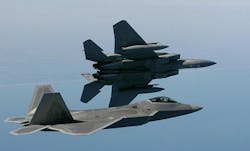DARPA eyes heavier reliance on artificial intelligence (AI) and unmanned aircraft in dogfighting
Officials of the U.S. Defense Advanced Research Projects Agency (DARPA) in Arlington, Va., will brief industry next week on the upcoming Air Combat Evolution (ACE) project, which seeks to increase trust in combat autonomy using human-machine collaboration in aircraft dogfighting.
The ACE project also will develop enabling technologies to enhance collaboration among humans and unmanned combat aircraft in a variety of combat scenarios.
The ACE industry briefings will be from 8 a.m. to 5 p.m. on Friday 17 May 2019 at the DARPA Conference Center, 675 N. Randolph St., in Arlington, Va.
Related: F-35 air-to-air missiles can now hit two unmanned aircraft at once -- changing air combat
ACE will apply existing AI technologies to aircraft dogfighting in experiments of increasing realism. ACE also will develop ways to measure, calibrate, increase, and predict human trust in combat autonomy performance.
The program will scale machine automation in aircraft dogfighting to more complex, heterogeneous, multi-aircraft, operational level simulated scenarios informed by live data. These scenarios are expected to lay the groundwork for future live, campaign-level experiments.
The idea is to enable one human pilot to become a more deadly warfighter by leading several semi-autonomous artificially intelligent unmanned aircraft, all from his own cockpit. This would shift the human role from sole operator to system mission commander.
In particular, ACE aims to enable a pilot to handle a broad, global air command mission while his aircraft and unmanned aircraft team members attack enemy aircraft and ground targets.
Related: Unmanned aerial vehicles get ready for prime time
ACE would have the human pilot handle complicated jobs like developing an overall engagement strategy, selecting targets, and choosing weapons, and enable the combat UAVs to handle aircraft maneuver and engagement tactics.
To achieve this, however, the human pilot must be able to trust his unmanned wingmen to conduct complex tactics in scenarios like dogfights where adversaries are within visual range.
Companies interested in attending the ACE briefings must register online no later than this Friday, 10 May 2019, at https://cvent.me/NkKdy?RefId=ProposersDayACE.
Email questions or concerns to DARPA's Dan Javorsek at [email protected]. More information is online at https://www.fbo.gov/spg/ODA/DARPA/CMO/DARPA-SN-19-46/listing.html.
Ready to make a purchase? Search the Military & Aerospace Electronics Buyer's Guide for companies, new products, press releases, and videos
